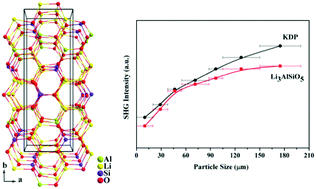Li3AlSiO5: the first aluminosilicate as a potential deep-ultraviolet nonlinear optical crystal with the quaternary diamond-like structure†
Abstract
Deep-ultraviolet (deep-UV) nonlinear optical (NLO) crystals play a crucial role in modern laser frequency conversion technology. Traditionally, the exploration of deep-UV NLO crystals is mainly focused on borates, while, the use of phosphates recently opened up a novel and promising non-boron pathway for designing new deep-UV NLO crystals. Extending this pathway to aluminosilicates led to the discovery of Li3AlSiO5, the first NLO crystal in this system. It crystallizes in the polar space group Pna21 (no. 33) with a quaternary diamond-like structure composed of LiO4, AlO4 and SiO4 tetrahedral groups. The compound exhibits a deep-UV cut-off edge below 190 nm and is phase matchable with moderate powder second harmonic generation (SHG) intensity (0.8KH2PO4). The band gap calculated using PBE0 is 7.29 eV, indicating that the cut-off edge of the Li3AlSiO5 crystal can be down to 170 nm. In addition, the compound is nonhygroscopic and thermally stable up to ∼1472 K. These results suggest that Li3AlSiO5 is a potential deep-UV NLO crystal. First-principles studies were performed to elucidate the structure–property relationship of Li3AlSiO5.


 Please wait while we load your content...
Please wait while we load your content...